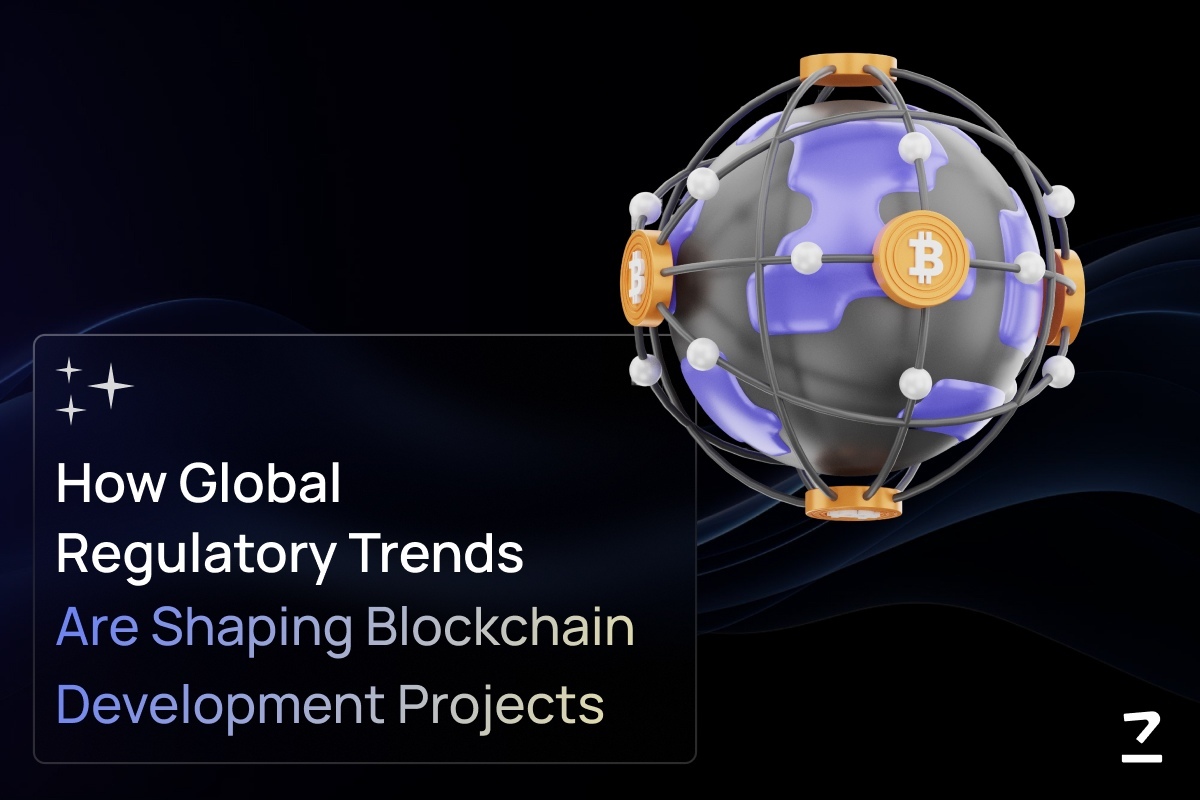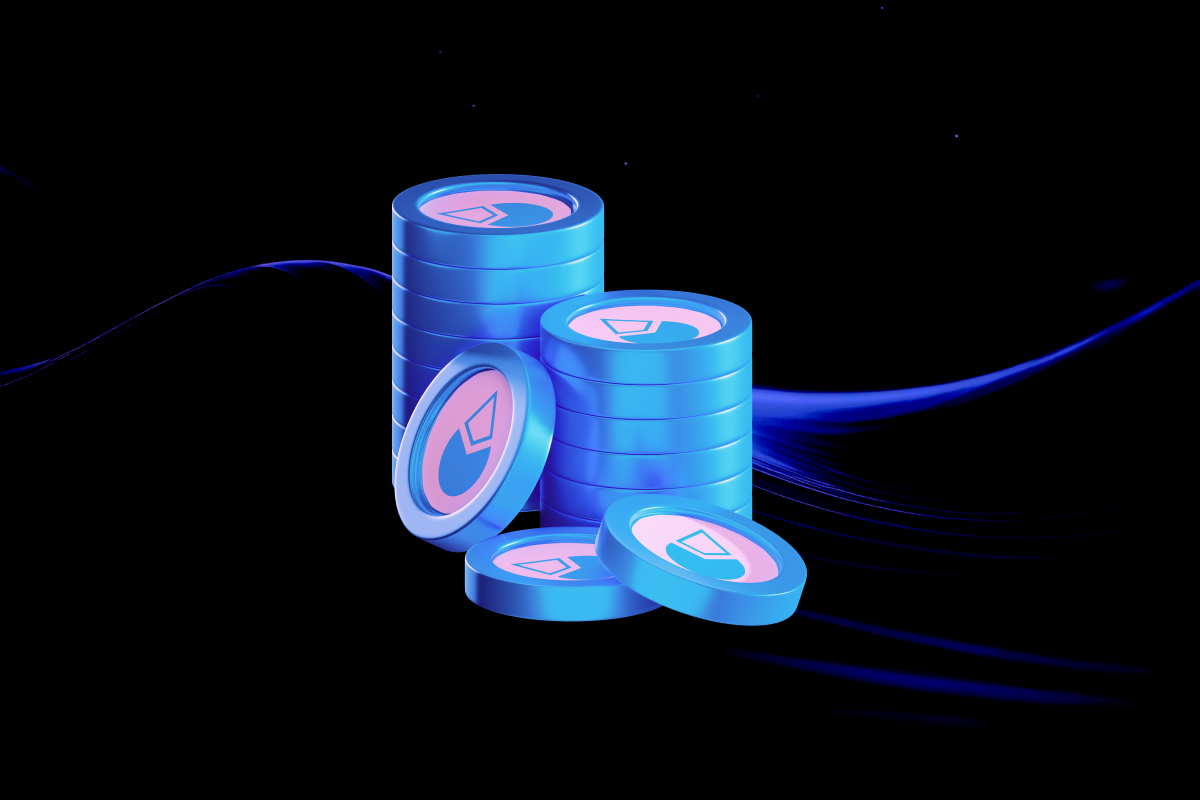SHARE THIS ARTICLE
Web3 Wallet Development in 2025: Why You Should Consider Account Abstraction
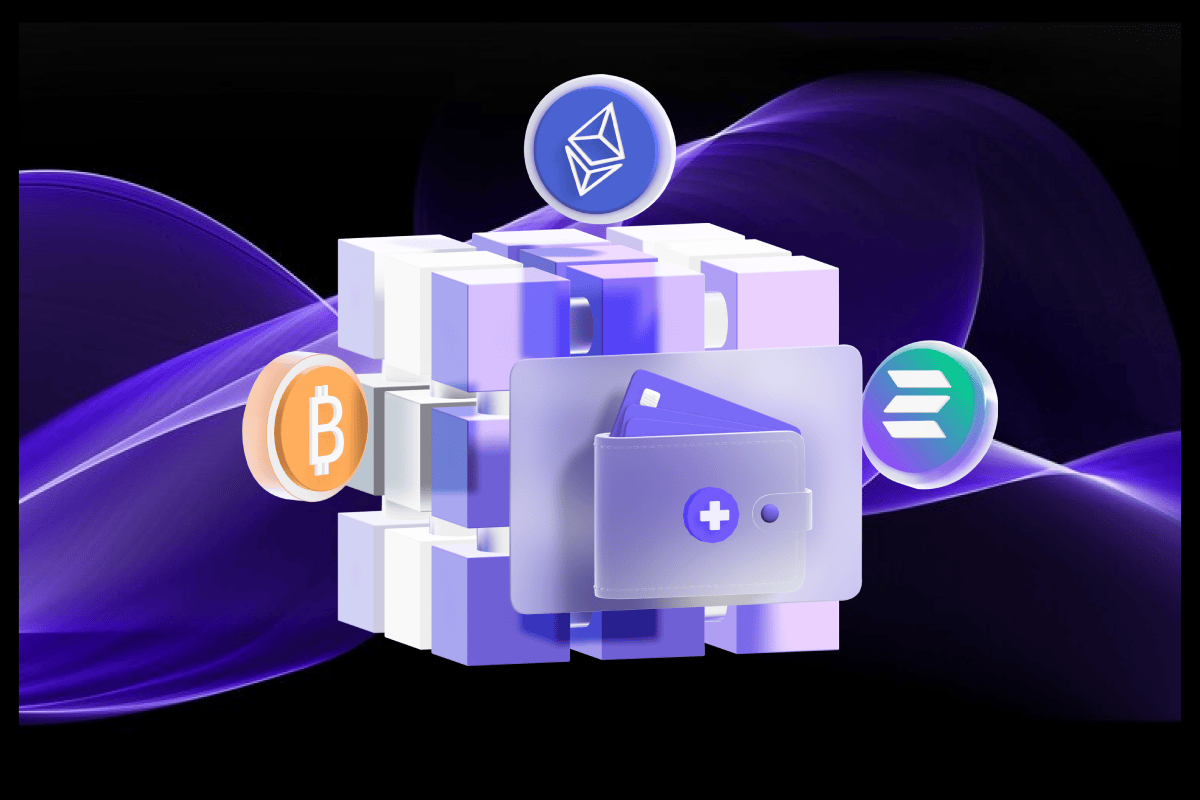
Web3 wallet development has come a long way, evolving from basic key-pair storage solutions to feature-rich applications that offer users control over their digital assets.
However, despite these advancements, traditional Externally Owned Accounts (EOAs) still come with limitations that hinder mainstream adoption. Managing private keys, dealing with gas fees, and handling transaction complexities remain some of the biggest pain points for both individual users and businesses building in the blockchain space.
The rise of Account Abstraction (AA) is changing the way wallets operate by making them more flexible, programmable, and user-friendly. Instead of requiring users to memorize and securely store private keys, AA enables smart contract-based wallets that offer better security, easier recovery options, and smoother user experiences. With Ethereum’s ERC-4337, EIP-7702, and ERC-7779 driving this shift, Web3 wallets are transitioning toward a new era where users no longer need to worry about gas fees, complex seed phrases, or single points of failure.
For developers, startups, and enterprises building in the Web3 space, understanding Account Abstraction is no longer optional—it’s essential. As we step into 2025, the demand for decentralized yet user-friendly wallets is at an all-time high, and businesses that fail to adapt risk falling behind. This article will break down why Account Abstraction is a game-changer for Web3 wallet development, how it improves security and UX, and what you need to consider when implementing AA-powered wallets.
If you’re looking to build a next-generation Web3 wallet that simplifies onboarding, improves security, and enhances transaction efficiency, Account Abstraction is the way forward. Let’s explore how this technology is shaping the future of decentralized wallets and what steps you can take to integrate it into your Web3 development strategy.
Understanding Account Abstraction and Its Impact on Web3 Wallet Development
Why Web3 Wallets Need Account Abstraction
For years, Web3 wallets have relied on Externally Owned Accounts (EOAs), which require users to manage their private keys. While this approach works, it places a heavy burden on users and introduces multiple risks, such as:
-
Lost access: If a user loses their private key or seed phrase, they permanently lose access to their funds.
-
Gas fee inefficiencies: Users must always hold ETH (or the native blockchain token) to pay for gas, adding friction to transactions.
-
Security vulnerabilities: EOAs are vulnerable to phishing attacks and hacking attempts because they don’t allow for programmable security features.
-
Complex UX: Signing transactions manually and remembering seed phrases make Web3 wallets difficult for non-technical users.
Account Abstraction solves these problems by shifting control from EOAs to smart contract wallets. This means that wallets can now operate with custom security policies, automated transaction handling, and gas fee optimizations, making Web3 wallets far more user-friendly and secure.
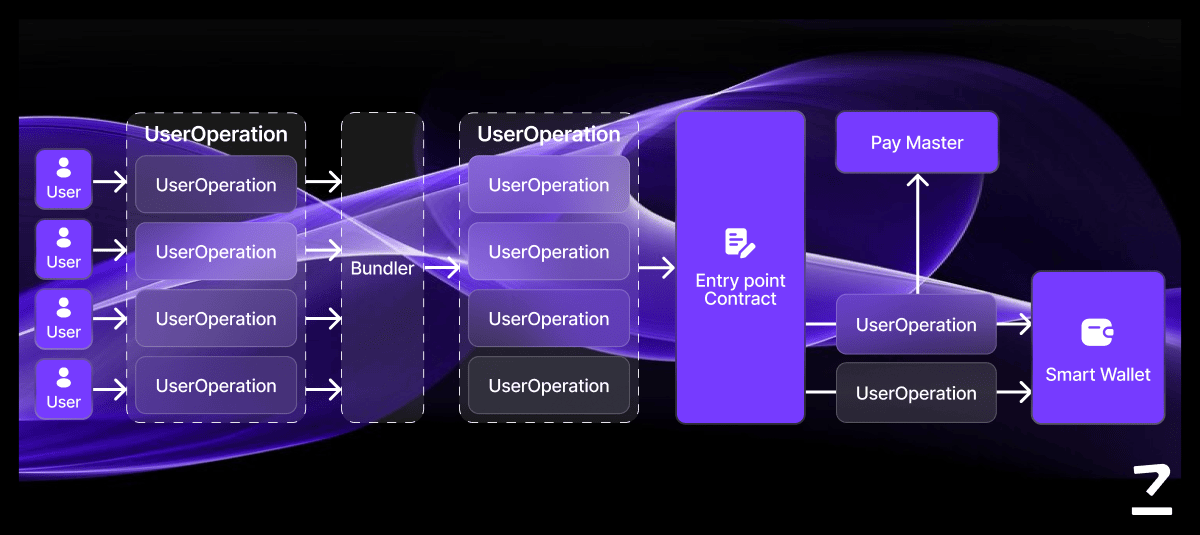
Key Features That Make Account Abstraction a Game-Changer
Account Abstraction isn’t just about removing private key dependency; it also brings several key features that redefine Web3 wallet functionality.
Programmable Wallet Security
Instead of relying on a single private key for security, smart contract wallets allow users to set customized security measures, such as:
-
Multi-factor authentication (MFA): Users can require multiple approvals before a transaction is executed.
-
Time-based spending limits: Wallets can enforce daily or weekly spending caps to prevent unauthorized large withdrawals.
-
Social recovery mechanisms: Users can assign trusted guardians (friends, family, or institutions) to help recover wallet access in case of loss.
Flexible Authentication Methods
EOAs rely solely on private key authentication, but AA-powered wallets can implement:
-
Biometric authentication (fingerprint, Face ID, etc.)
-
Multi-signature approvals (multiple parties must approve a transaction)
-
Hardware security integration (support for Ledger, Trezor, and other hardware wallets)
These features provide a higher level of security while maintaining usability.
Gasless Transactions & Fee Abstraction
With AA, users can pay gas fees in any token instead of being forced to hold ETH. This is possible through Paymasters, which can:
-
Allow gas sponsorships where dApps cover transaction fees for users.
-
Enable subscriptions and recurring payments without manual approval.
-
Let users pay gas fees using stablecoins (like USDC, USDT, or DAI).
By removing the need for users to hold ETH just for gas fees, Web3 wallets become more accessible to mainstream users.
Automated Transactions & Smart Execution
AA allows wallets to execute transactions without constant user approval. Some use cases include:
-
Auto-staking and yield farming: Users can pre-approve smart contract interactions to optimize returns.
-
Subscription-based payments: Monthly dApp subscriptions or automatic loan repayments in DeFi protocols.
-
Delegated spending: Businesses can create wallets with role-based spending permissions.
This makes Web3 wallets feel more like traditional banking apps, improving usability.
Key Innovations in Web3 Wallet Development (2025)
Account Abstraction is gaining traction due to several Ethereum proposals and advancements in smart contract wallets:
-
ERC-4337: Introduces smart contract wallets without modifying Ethereum’s consensus layer. It introduces Bundlers to batch transactions and Paymasters to sponsor gas fees.
-
EIP-7702: Bridges the gap between EOAs and smart contract wallets by allowing EOAs to temporarily act as smart contract accounts.
-
ERC-7779: Enhances interoperability between different blockchain ecosystems, ensuring seamless cross-chain wallet interactions.
-
Layer-2 scaling solutions: StarkNet, zkSync, and Arbitrum are integrating Account Abstraction to reduce costs and improve transaction speeds.
How Businesses & Developers Benefit from AA-Powered Wallets
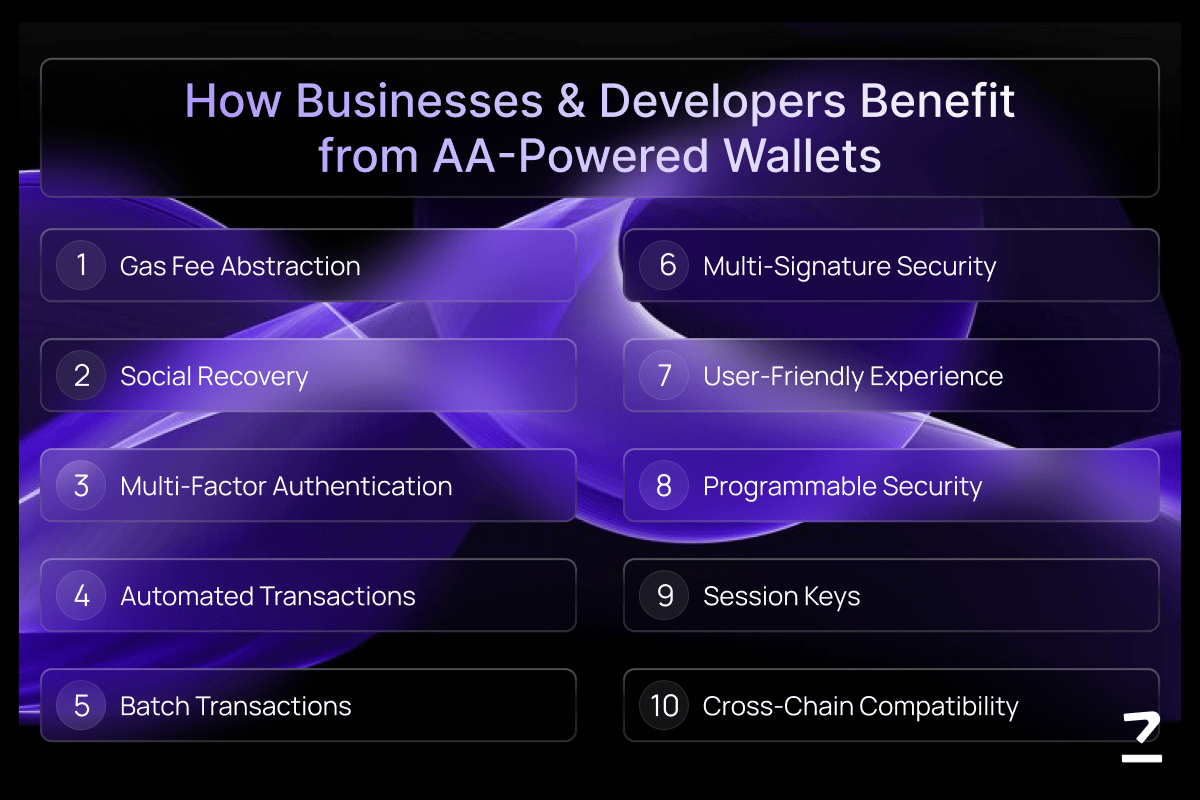
For businesses building Web3 wallets, integrating Account Abstraction provides several advantages:
-
Onboarding mainstream users: Removing gas fees and seed phrases reduces barriers for non-crypto users.
-
Better fraud protection: Programmable security policies prevent unauthorized access.
-
Optimized for DeFi and gaming: AA wallets enable seamless staking, automated lending, and in-game transactions.
-
Ideal for DAOs and enterprise use cases: Multi-user access controls make AA wallets perfect for corporate treasury management.
With these innovations, Web3 wallet development is shifting towards user-friendly, secure, and scalable solutions, ensuring that the next generation of wallets is ready for mass adoption.
Why Account Abstraction is Essential for Web3 Wallet Development
How Account Abstraction Aligns with Ethereum’s Roadmap
Ethereum’s long-term vision has always been about making blockchain technology more scalable, accessible, and developer-friendly. Account Abstraction plays a crucial role in that vision by removing unnecessary complexities from wallet interactions. Instead of forcing users to deal with gas fees, seed phrases, and cryptographic signatures, Ethereum is moving toward a more flexible transaction model where users can interact seamlessly with dApps and protocols.
With the introduction of ERC-4337 and other AA-related standards, Ethereum aims to:
-
Reduce reliance on EOAs and shift towards smart contract wallets as the default.
-
Enhance wallet security with programmable access control and multi-factor authentication.
-
Optimize gas efficiency by introducing batching, paymasters, and relayers.
Any Web3 wallet that doesn’t incorporate Account Abstraction soon will likely become outdated, as the Ethereum ecosystem is moving towards widespread AA adoption.
Industry-Wide Adoption of Account Abstraction
Several major projects have already embraced Account Abstraction to improve wallet usability and security:
-
MetaMask Smart Wallet: MetaMask is actively working on an AA-integrated wallet to allow gasless transactions and better recovery mechanisms.
-
Safe (formerly Gnosis Safe): A pioneer in smart contract wallets, Safe has incorporated multi-signature approvals and smart permissions using AA principles.
-
Argent Wallet: Provides social recovery, session keys, and flexible authentication, setting the standard for user-friendly Web3 wallets.
-
zkSync & StarkNet: These Layer-2 blockchains have integrated Account Abstraction to improve transaction speed, reduce gas costs, and enable seamless dApp interactions.
The trend is clear: Wallet providers and blockchain networks are moving towards AA-powered solutions. Any new Web3 wallet development must align with these trends to remain competitive.
The Risks of Not Adopting Account Abstraction
For businesses and developers building Web3 wallets, not integrating Account Abstraction can result in major drawbacks:
-
Higher user drop-off rates – Wallets with complicated private key management deter non-technical users.
-
Lack of scalability – Traditional EOAs increase transaction costs and network congestion.
-
Security concerns – AA wallets provide advanced security features that EOAs lack, making EOAs more vulnerable to attacks.
-
Incompatibility with future Ethereum upgrades – As Ethereum moves towards a more AA-driven future, wallets that don’t adopt these features will face integration challenges with new protocols.
Implementing Account Abstraction in Web3 Wallets
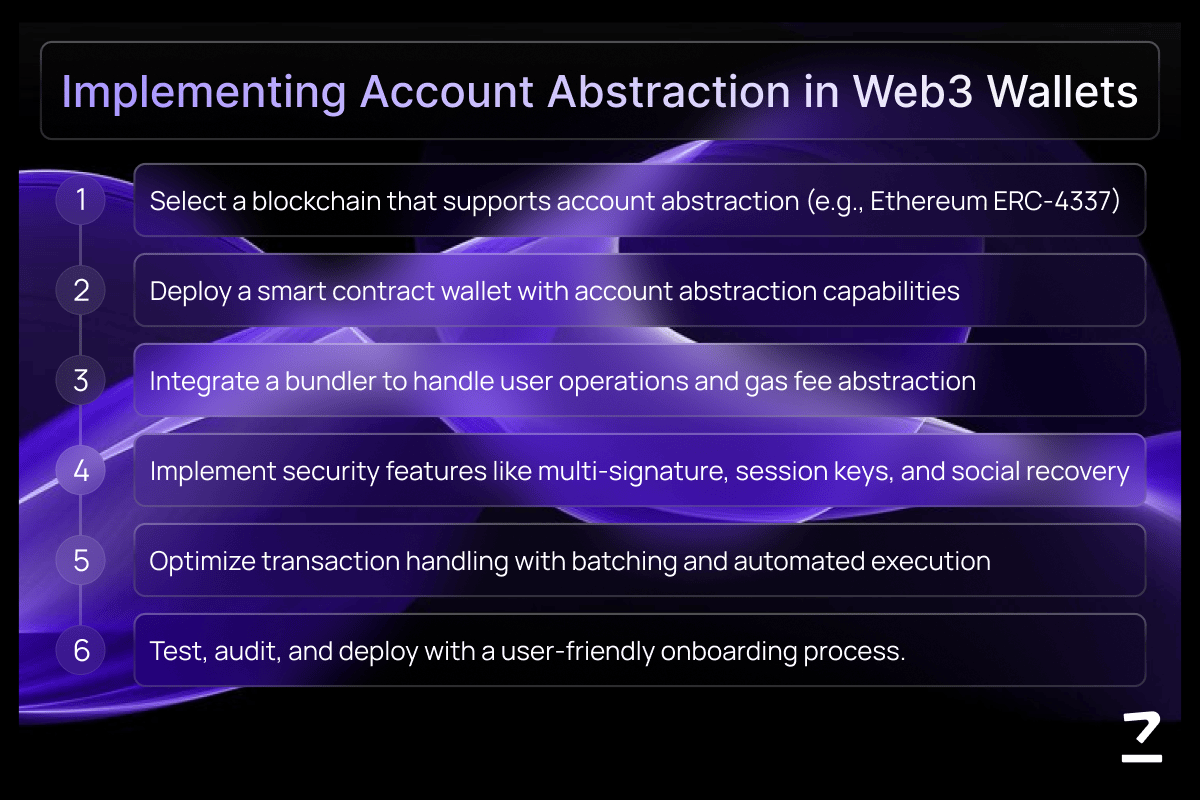
Step-by-Step Guide to Integrating AA
Choose the Right Smart Contract Architecture
-
Implement ERC-4337-compliant smart contract wallets.
-
Ensure compatibility with Layer-2 scaling solutions like zkSync, StarkNet, or Arbitrum.
Set Up Bundlers for Transaction Processing
-
Bundlers aggregate transactions, reducing network congestion and gas fees.
-
Developers must connect wallets to Bundler service providers that handle user operations efficiently.
Implement Paymasters for Gasless Transactions
-
Paymasters allow dApps or third parties to sponsor gas fees for users.
-
Set up a Paymaster contract to allow users to pay gas in ERC-20 tokens.
Integrate Multi-Factor Authentication & Recovery
-
Add biometric authentication and social recovery features.
-
Implement time-based spending limits and session keys for automated transactions.
Optimize UX & Security Best Practices
-
Ensure wallets support one-click transactions.
-
Conduct smart contract security audits to prevent vulnerabilities.
-
Implement role-based access for multi-user wallets.
Tools and Frameworks for Developers
-
Ethereum’s ERC-4337 SDK – Standard toolkit for building AA wallets.
-
Alchemy, Biconomy, and StackUp Bundlers – Reliable services for transaction processing.
-
Layer-2 AA integrations – zkSync, StarkNet, Optimism for cost-efficient transactions.
-
Safe (Gnosis) SDK – For setting up multi-sig and role-based wallet security.
Challenges & Considerations in Adopting Account Abstraction
Smart Contract Wallet Gas Costs
-
Smart contract wallets require higher gas fees compared to EOAs.
-
Using Layer-2 solutions like StarkNet, zkSync, or Arbitrum can help mitigate costs.
Security Risks
-
Smart contract vulnerabilities can lead to exploits if not properly audited.
-
Regular security audits and formal verification are necessary to ensure wallet integrity.
Adoption Barriers & Developer Complexity
-
Many dApps and DeFi protocols are still built for EOAs and may not support AA wallets.
-
Developers must learn new architectures and integrate Bundlers and Paymasters correctly.
Regulatory and Compliance Considerations
-
Programmable wallets introduce new legal challenges in different jurisdictions.
-
Governments may enforce know-your-customer (KYC) and anti-money laundering (AML) regulations on smart contract wallets.
As Ethereum and Layer-2 networks continue refining Account Abstraction, these challenges will likely decrease, making AA-powered Web3 wallets the standard.
Future Outlook & Predicted Timeline for Account Abstraction
What’s Next for Account Abstraction?
Account Abstraction is still evolving, and while ERC-4337 has laid the foundation, the industry expects further refinements in how AA is implemented. Some key areas of development in the next few years include:
-
More Layer-2 integration: Expect deeper adoption of AA on Ethereum’s Layer-2s to enhance efficiency and reduce gas costs further.
-
Better developer tooling: The emergence of more accessible SDKs and APIs for AA-powered wallets.
-
Standardization of Paymasters and Bundlers: More dApps and wallets will incorporate these features to improve gas efficiency and onboarding.
-
Institutional adoption: Enterprises and DAOs will begin using AA-powered wallets for treasury management and automated transactions.
Predicted Timeline for Mass Adoption
| Year | Development Milestone |
| 2025 | EIP-7702 finalization and early adoption, wider ERC-4337 adoption among wallets and DeFi apps. |
| 2026 | Paymasters and Bundlers become standardized, Layer-2s launch dedicated AA-compatible wallet solutions. |
| 2027 | AA-powered wallets surpass EOAs in usage, Ethereum considers deeper protocol-level AA integration. |
| 2028+ | Ethereum core upgrades enable AA at the protocol level, making smart contract wallets the default. |
Final Thoughts
Account Abstraction is no longer just a concept—it is rapidly becoming the new standard for Web3 wallet development. As Ethereum continues to refine AA-related frameworks and Layer-2 solutions integrate native support, the shift toward smart contract-based wallets is inevitable.
For businesses, developers, and projects working on Web3 wallets, the next steps should be:
-
Start experimenting with AA-powered wallets: Tap into ERC-4337 toolkits and developer documentation.
-
Ensure compatibility with upcoming Ethereum upgrades: EIP-7702 and future protocol-level integrations will change how wallets function.
-
Educate users and onboard them to AA wallets: Provide smooth migration paths for existing users from EOAs to AA wallets.
-
Adopt best practices in security and UX: Implement Paymasters, Bundlers, and automated transaction flows for an optimal user experience.
The future of Web3 wallets is programmable, gas-efficient, and user-friendly. Companies that adopt Account Abstraction early will be well-positioned to lead in the next wave of blockchain innovation.
If you're developing a Web3 wallet or planning to integrate AA into your product, now is the time to act. Build your next-gen Web3 wallet with Codezeros. Our experts specialize in Account Abstraction, smart contract wallets, and blockchain security. Contact us today to get started!
Post Author

With a genuine love for all things blockchain, Jay is one of the Blockchain Enthusiasts and Consultants at Codezeros. With a fresh and innovative perspective on the world of blockchain, Jay provides strategic guidance and implementation support to clients across diverse industries and helps them unlock new opportunities.
Partner with Codezeros to future-proof your Web3 wallet with Account Abstraction.
Web3 adoption depends on accessibility. Codezeros helps you create smart contract wallets that integrate gasless transactions, social recovery, and automation—so users enjoy security without complexity.

